Recap of 47th IT Press Tour in Portugal
With 6 European companies
By Philippe Nicolas | December 19, 2022 at 2:01 pmThe recent 47th edition of The IT Press Tour took place in Lisbon, Portugal, early this month. It was the opportunity to meet 6 European companies all playing in storage infrastructure, data management, data protection and multicloud: Atempo from France, Cleondris from Switzerland, LINBIT from Austria, NGX Storage from Turkey, Nuclia from Spain and Tiger Technology from Bulgaria.
Atempo
Founded 30 years ago in 1992 in France under the name Quadratec, it is a reference in data protection and data management software, with more than 2,000 customers and more than 200 employees. It sells its products exclusively via a channel built for a few decades to address some vertical use cases beyond a generic approach.
It has had several lives as an independent entity, under ASG – Allen Systems Group – umbrella and back as an independent firm since 2017 when Luc d’Urso acquired Atempo from ASG via his kickstart legal entity. On the history timeline, in 2006, the firm has acquired Storactive to become Lina, in 2017, picked Synerway, another French data protection ISV, and finally in 2019 swallowed Lima and has initiated an AI lab named Nextino.
As of today the product line is split between data protection and data management from SMB to large enterprises aligned with vertical industries and domains. The product family is represented by the historical strong software Tina aka Time Navigator, Lina or Live Navigator, the NEW Continuity and Miria.
Let’s dig a bit into Miria. As we know the solution is probably one of the most open in its category, supporting a variety of file servers from NAS to parallel file systems, access methods, private or public clouds via S3 and related object stores and finally tape. Miria couples a few key functions like analytics, data movement and data protection.
One of the recent few announcements was the partnership with Quantum to couple Tina with Quantum DXi and the Panasas one around Miria. There were agreements with Storj, CIQ around Rocky Linux, DataCore for Swarm or Seagate for Lyve. Some of us also watched the OVHcloud cold archive service built on IBM tape library and 3592 tapes controlled and managed by Miria.
Miria was also listed in the recent Coldago Map 2022 for Unstructured Data Management as a challenger without any leader in the domain.
The team has shared ambitious elements for 2023 and beyond around data immutability, data integrity, cost control and sustainability. Among these we saw fast-scan and block de-dupe for S3 and some container flavors.
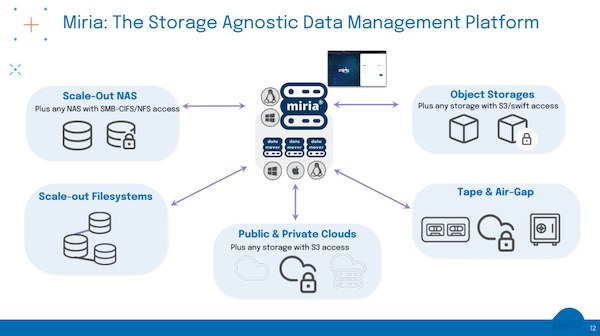
Cleondris GmbH
The firm is a Swiss software company developing add-ons for NetApp systems. The tour edition was the opportunity to meet Christian Plattner, CEO and founder, discovered at NetApp Insight 2018 in Las Vegas, NV.
The company, founded in 2006 in Zurich, was launched with the mission to offer special software for ONTAP and to deliver these solutions for each NetApp product iteration like Clustered ONTAP, SnapDiff or SnapMirror. Today, 3 products are available: SnapGuard, Data Manager and Cleondris HCC:
- SnapGuard targets ransomware with the capability to potentially block usual requests via FPolicy module on ONTAP. It implements a sort of firewall for NFS and SMB file access.
- Cleondris Data Manager (CDM) is an orchestrator for NetApp snapshot mechanism and controls how you backup and restore any ONTAP-based filer.
- HCC is a special add-on for SolidFire when users deploy a cluster. It facilitates failover of VM-based workloads hosted in such clusters. This product is on NetApp price list but it is sold only to users with already deployed SolidFire, outside of these, the NetApp product is end of life.
All firm’s solutions rely on the Cleondris Appliance, a VM-based appliance, running CentOS, PostgreSQL and other Cleondris specific Java Software.
The appliance supports VMware OVA, Linux RHEL/CentOS and physical server and is potentially available on demand on AWS and as a Docker container. AWS will be officially available soon and the product already supports Amazon FSx for NetApp.
CDM offers a comprehensive GUI to schedule SnapMirror and is capable of restoring VMware objects with a fine granularity: Full VM restore, VM clone, VMDK restore, VMDK attach to offer file-level restore, Datastore clone and DR with HCC. Of course NDMP control is integrated as well. The vendor is able to monitor all data movements coupled with vCenter and both source and target storage devices. As CDM sits in the back and monitors all Snapshots and SnapMirrors jobs, it is the right tool to globally see all protection tasks and trigger any restore. It is capable to index all files on any ONTAP volumes and thus know perfectly if all files are protected by a Snapshot or SnapMirror jobs and present in a “backup” image, tracking also versions. The company belongs to the small list of official partners for SnapDiff v3. In terms of scalability, one Cleondris instance is able to support 10 of thousands of VMs and hundreds of NetApp clusters.
SnapGuard illustrates the pioneer role of the firm in ransomware protection for NetApp systems. It is available for FAS, AFF, Select, CVO and Amazon FSx for ONTAP. This module is able to scan 300,000 FPolicy messages and 16k ransomware checks per second and CPU core. The effect is powerful with immediate blocking mode with export to SIEM solutions for advanced analysis.
Cleondris is licensed per ONTAP or ESXi node whatever is the volume of data or number of users or number of ONTAP volumes.
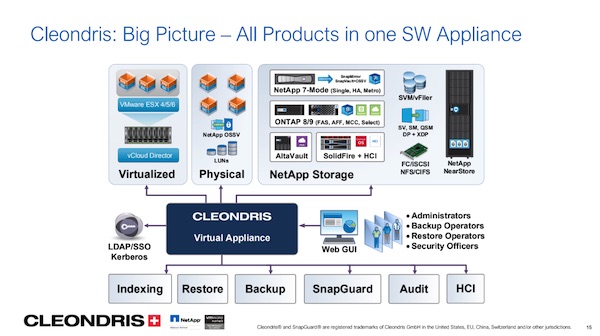
LINBIT
The reference in Linux data protection joined this edition as well and it was the opportunity to get an update about DRBD, the Distributed Replicated Block Device engine, directly from the CEO and founder, Philipp Reisner, who started this project during his studies more than 20 years ago.
Since that, the company has launched another product named Linstor, with a portion of the company name in the product name. Perhaps a recognition of the disconnect between a recognized product and an unknown company, people having difficulties to associate the two.
LINBIT was founded in 2001 in Austria without any VC and employs around 35 people today. The company is profitable and fully owned by its founder.
DRBD as a famous solution by the simple fact that the product is deployed more than 2 million times. It is used by large well known brands like Amazon, Apple, Cisco, Google, IBM, Intel, Oracle, Red Hat or Yahoo!.
It is the preferred block level replication for Linux. As a block oriented engine, the copy engine works above any block device, physical or logical, and below the file system layer. A block device could be a single partition, a LVM volume, a MD volume with 0, 1, 4, 5, 6 or 10 assembly mode, a VDO (Virtual Data Optimizer from Permabit acquisition) entity or a zVol from ZFS with different flavor. DRBD supports any initiators and targets supported by Linux such LIO, STGT, SCST, letd, iSCSI and of course NVMe-oF and especially TCP. It offers synchronous and asynchronous mode and up to 32 replicas with version 9.x on any TCP/IP network.
The mode can be mixed between one source and its targets. Multiple primaries are also possible for cluster needs like GFS or OCFS2. Cascading is not supported yet but as multiple replicas are possible users can build interesting configurations but still add load on the primary. Users can even configure the engine to be diskless at the source copying memory data to remote devices. The engine implements partial resync to only consider blocks not already present or synchronized. The replication can work in multiple directions with only one master source at a time except on some specific use cases such cluster mentioned above or live migration of VMs. During a failover, the unmount of file system then detach of volume triggers the source to release its primary role and vice-versa, as soon as a volume is locally attached and the file system is mounted, the initiator is set and the replication direction is decided. But LINBIT protects this and only one source can be active at a time preventing data corruption, except the 2 cases listed above.
The team has launched a Windows flavor, currently in 1.0 released in 1Q22 supporting Windows 7SP1, Windows 10, Windows Server 2008, 2016 and 2019.
DRBD 9.0 and 9.1 can be downloadable here, the 9.2 announced October 10 is also available there.
The session also covered LINBIT’s Kubernetes strategy essentially covered by Linstor, a dedicated storage solution for Kubernetes. As the DNA of the company, the product is open source under the GPL license and goes beyond Kubernetes also supporting OpenNebula, OpenStack and OpenShift but it is above all a storage volume management for Linux. It’s obvious that the product targets persistent volume for stateful workloads.
The architecture resides on multiple services with active/passive manager named the Linstor controller, one active at a time, and a series of agents, called Linstor Satellite. The Linstor Controller is managed via API or CLI. Linstor also integrates DRBD for data resiliency at the block level.
For Kubernetes, it exposes CSI and LINBIT also develops an operator named Piraeus with Doacloud. This tool is a sandbox CNCF project. As an analogy it plays the same role as Rook for Ceph. Definitely one of the few right storage management services to associate for each Kubernetes cluster deployment.
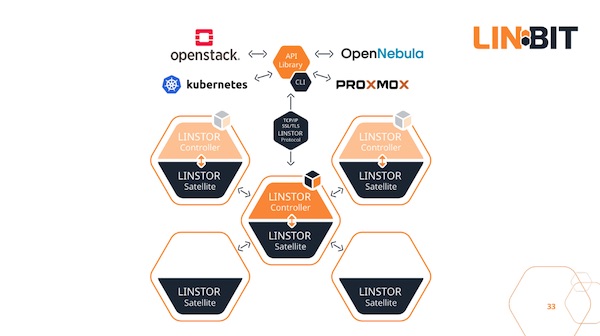
NGX Storage
The company joined also with its CEO Beyhan Caliskan and product management leader Pradeep Ganesan. For most of us, we discovered the company launched in 2015 in Ankara, Turkey, with R&D in Bangalore, India and Vancouver, Canada, with 200 customers in Europe. The business is done exclusively with channels and the team is looking for new partners as they prepare something new with a plan to unveil it in February.
The firm has designed and developed essentially 2 models of unified storage, the NGX-H and the NGX-AFA, and it seems to be a NetApp killer, at least this is their target with already many replacements successes.
The NGX-H for Hybrid embeds SSDs and HDDs for a total capacity of 20PB with SAS, SATA or NVMe internal storage connectivity. It is a unified storage system with dual controllers working in active/active mode exposing block with FC and iSCSI, file with NFS and SMB and object with S3. The team has selected Western Digital JBOD chassis connected to 2 access servers. The system runs FreeBSD and uses the NFS kernel module, for SMB it is Samba and for S3, they use MinIO. External network interfaces use 32Gb FC HBAs and 100GbE NICs.
The NGX-AFA develops similar characteristics, except it’s a full flash solution with SAS and NVMe connectivity.
On the data service side, the company has made clear choice and the solution is comprehensive with:
- Inline data reduction with both compression and de-dupe with a zero detection mechanism,
- Intelligent tiering at multiple levels in the system and all data are always written first to the flash layer,
- Accumulation write operations for SSDs what they call Random Flash Sequential Disk (RFSD),
- Data Protection with RAID (level 1, 5, 6, 10, 50 and 60) plus triple parity and 4-way mirrors, snapshot, clone and replication over TCP but erasure coding is not yet available,
- Non disruptive upgrade both for the software and the hardware,
- And also encryption with AES-256, WORM and TOE.
To boost I/O operations the engineering team implements wide-striping to maximize the bandwidth and delivers expected throughput.
In terms of deployment, classic local racks exist but also metro cluster with what they call MetroScale Cluster leveraging 4-way mirroring, 2 on each site.
Pradeep Ganesan, product management lead for the company, unveiled the future plan for the company, a scale-out NVMe block storage software.
They jumped into the wagon to deliver a scalable disaggregated block storage fueled by end-to-end NVMe. The architecture reminds us what some vendors are doing as they leverage the any-to-any connection between access nodes and storage nodes. They’re using Intel SPDK so everything is running in user space.
The architecture has 2 layers. The first is the back-end storage where the storage node with physical NVMe devices reside exposing native block interfaces via InfiniBand and RoCE connectivity. The second is the controller layer or access nodes, connected to the back-end that expose logical storage entities to clients machines, connected with RDMA/TCP. The beauty of this model is the independent scalability between the controller and storage nodes able to offer a multipath for clients. The technique used here is based on sharding with volumes controlled by the access nodes working in a stateless mode.
In terms of data protection, the development team implements replication within the logical array.
The engineering team develops a write anywhere data placement layer based on a log-structured model and everything is parallelized. Thus they optimize how blocks are written on final NVMe medias having a positive effect on the endurance. The goal is to deliver a sub-millisecond latency system with a throughput of 9GB/s per controller or access node and of course enable NVMe-oF. The first release planned for February 2023 will scale to a few tens of petabytes but the ultimate goal is multiple of hundreds of petabytes.
This project is very ambitious and plays vs. famous names such Kioxia Kumoscale, Lightbits Labs or ones from usual suspects. And we also remember stories that hit the wall like Excelero, acquired for a penny by Nvidia, E8 Storage, swallowed by AWS, or Exten Technologies disappeared inside OVHcloud. They also have in mind some other pioneers we met in the past like Apeiron or Mangstor morphed into Exten. More info soon as the product should be launched in February 2023.
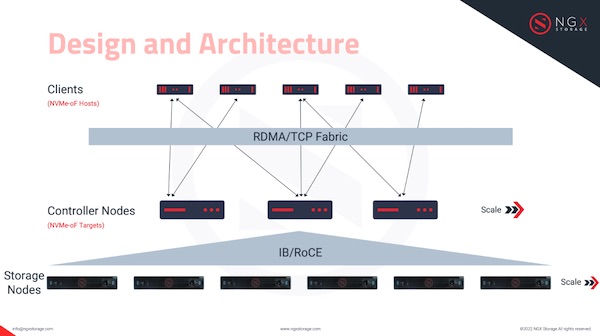
Nuclia
The entity, a young Spanish software company based in Barcelona, Spain, was a great surprise as the solution really rocks. Let’s dig a bit.
First the company was founded in 2019, with today 25 employees, and received so far €5.5 million as a seed round from Crane Ventures Partners and Elaia. The founding team already collaborated together in past project like Iskra.cat, Intranetum.com or Onna.com.
The challenge they address is well known and huge so it invites several players to think about how to index the content of a large volume of unstructured data. As we all know indexing metadata is pretty easy, well mastered by plenty of solutions, but the real grail is the content. The recent Coldago Map for Unstructured Data Management unveiled 20 players coming from the storage industry but only a very limited number of them know how to deal with content. One of these is Data Dynamics that understood that need very early and decided to acquire the Indian company Infintus Innovations Pvt. Ltd in 2019, 3 years ago.
The problem can be summarized in a few lines:
- The volume of data explodes especially the unstructured data type, it is true for the number of files, the nature of them and their size,
- The format of files themselves need the right level of interpretation. Again metadata, extended attributes of files can be extracted via classic file system level tools or API calls but the internal data is another story. And let’s consider the language dimension associated with a large variety of data sources, these create a certain complexity.
- And keywords have hit a wall, it is not enough to manage content with this approach.
- So clearly the market requires a new level of solutions that are able to discover all types of file content to enable a new level and more comprehensive knowledge to build a real analytics landscape you can navigate into.
So Nuclia has jumped into this mission with new ideas, talents and expertise. The key decision they made is to offer AI-based search as-a-Service with a simple way to submit unstructured data to the index engine without any special code to generate. The architecture is a multi step process controlled by the Nuclia Desktop, and SDK or a REST API. The other element central and fundamental in Nuclia’s approach is the design of a dedicated database, the famous open source vectorized NucliaDB, as they didn’t find anyone on the market suitable for their need.
The service exposes an easy 6 steps workflows with:
- selection of any data source,
- with any language for any kind of data,
- then an extraction from the source whatever the type text, audio or video,
- establish insights which is more than a keyword being a trend or a meta topic if we can say that,
- then creates vectors
- to insert info as records in the NucliaDB.
And the beauty of this is the Google-like search user experience with just one field to access content.
So far the company has identified and chosen some use cases more vertical ones but not yet data management solutions like the ones mentioned in the last Coldago Map 2022 for Unstructured Data Management.
Try the solution, we tried it and it delivers very interesting results in a simple easy experience: go to https://nuclia.com/sign-up/.
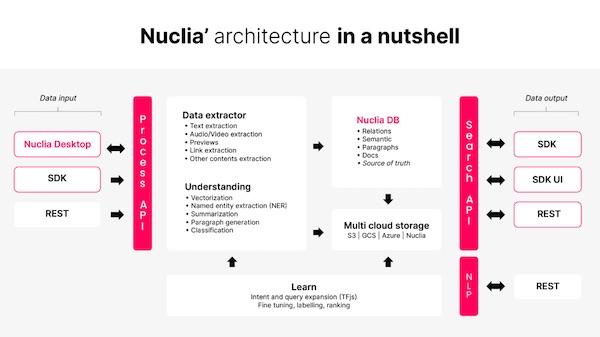
Tiger Technology
They have launched and promoted with us early this year its On-Premises First hybrid strategy aka OPF. This model simplifies deployments and refers to on-premises sites as the data reference. Then it is coupled with cloud storage entities such Azure and presents a global namespace spanning local and remote data sets.
Recognized expert in Windows and in NTFS particularly, the company flagship product Tiger Bridge consolidates all data as NTFS files on the appliance, potentially used locally or with embedded applications or via SMB.
Strong in M&E, the firm has decided to address a new vertical with healthcare with medical imaging systems.
It leverages the cloud to process specific AI related tasks and discover new information to then add them as extended attributes or metadata to files. These enriched files are then fully available on the gateway exposed as native NTFS files and boost pathologists missions.
The second vertical invites to think that the company will continue in that direction making the product more horizontal so more generic. At the same time, the team prepares a Linux-based appliance flavor to address some environments where Linux is more present and adopted than Windows. Lots of progress for the company that clearly accelerated since our last meeting. Expects some other news.
Tiger Technology is listed as a challenger in the last Coldago Map 2022 for Cloud File Storage. Again visit coldago.com or .net for more details.
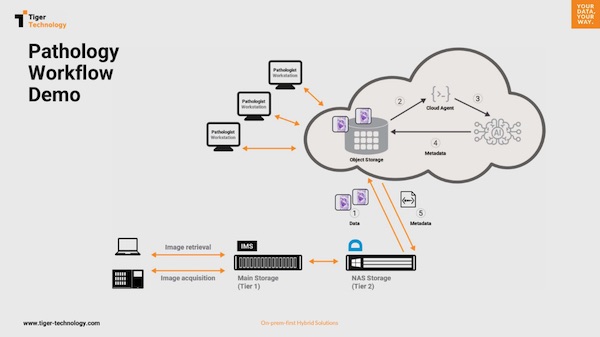













 Subscribe to our free daily newsletter
Subscribe to our free daily newsletter

